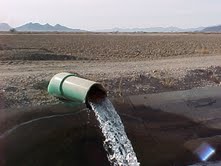Editor’s Note: This guest editorial first appeared in the March 2011 issue of Arizona Agriculture, Arizona Farm Bureau’s monthly publication to farmers and ranchers.
By Mark Estes, Salt River Project
 As Salt River Project (SRP) celebrates the Theodore Roosevelt Dam centennial this spring, we continue our commitment to a sustainable water future. Our long-term stewardship of central Arizona’s water supply has been the economic catalyst in creating one of the more desirable metropolitan areas in the desert southwest.
As Salt River Project (SRP) celebrates the Theodore Roosevelt Dam centennial this spring, we continue our commitment to a sustainable water future. Our long-term stewardship of central Arizona’s water supply has been the economic catalyst in creating one of the more desirable metropolitan areas in the desert southwest.
The Salt River Valley was little more than a few outposts and prospecting camps when the first modern irrigation ditch was organized in 1867. The eventual success of this undertaking spurred the formation of other irrigation concerns. Most of these used ancient canal networks created and maintained by the Hohokam civilization more than 1,000 years earlier.
As settlements cropped up valley wide, civic leaders realized a dam was needed to form a reservoir that would regulate the flow of the Salt River and provide a sustainable water supply to irrigate the lands. Local farmers and businessmen organized to lobby the U.S. Congress for a federal reclamation law that would throw the weight of the federal government behind large-scale reclamation projects.
It took the progressive vision of President Theodore Roosevelt and the persuasive power of private citizens to get the National Reclamation Act through Congress in 1902. Roosevelt had championed economic development through reclaiming the arid lands of the West, a concept crucial to city-building in central Arizona.
SRP was organized in 1903 when Valley landowners pledged their property as collateral for a government loan to build Roosevelt Dam, designed and constructed by the U.S. Reclamation Service. The dam was one of the first major projects authorized under the new reclamation law.
The dam harnessed the Salt River and created the largest reservoir serving the Valley. Roosevelt Lake provides 70% of the surface water available to SRP shareholders and customers. Roosevelt Dam now is the cornerstone of an extensive water delivery system that includes six dams on the Salt and Verde rivers, and is augmented by the C.C. Cragin Dam on the Mogollon Rim.
SRP delivers up to 1 million acre-feet annually to municipal, industrial, agricultural and residential users within our reservoir district. We also work with the U.S. Forest Service to oversee a 13,000-square-mile “watershed” or natural drainage area in the mountainous regions north and east of the Valley.
Precipitation runoff from this watershed flows into SRP’s reservoir system which, in turn, feeds a water-delivery network comprising 131 miles of main canals, 1,132 miles of laterals and ditches, and 255 large-capacity wells. SRP also offers leading-edge, cost-effective water measurement and instrumentation, groundwater services, and water management services.
While our mission has evolved with Arizona’s growth and development, SRP’s core function remains to provide a sustainable water resource for central Arizona. That’s why we introduced “Together We Conserve” earlier this year.
The campaign emphasizes that water stewardship, including conservation, is closely tied to the economic viability of our cities and state. We hope that the responsibility of water stewardship isn’t just something that just SRP does – it’s something we all must do. We’re all shareholders in this future.
Related articles
- Arizona Offers Statewide Solar Hot Water, Energy Efficiency Rebates (solarfeeds.com)
- Salt River Project (SRP)
- Arizona Farm Bureau (AZFB)


